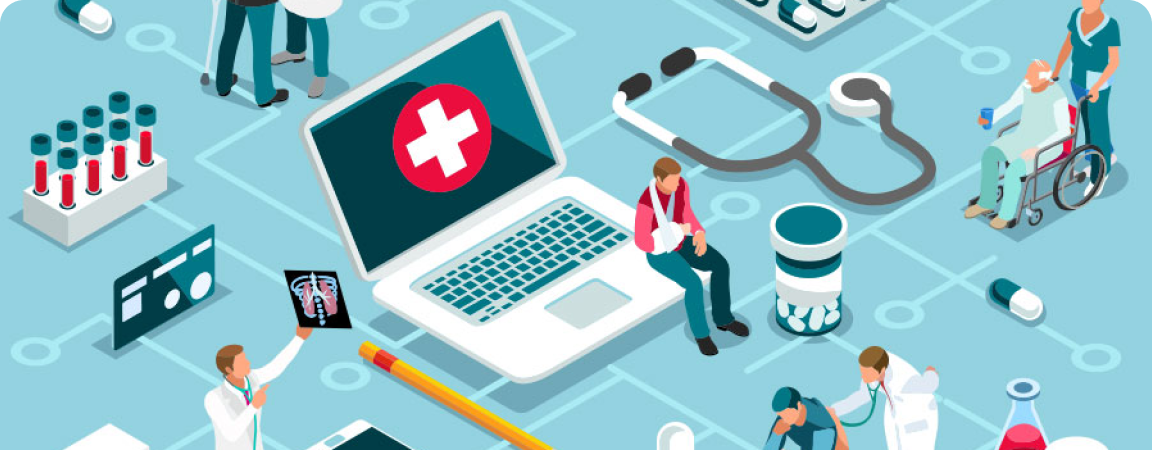

Almost every provider has a patient portal, but a true digital health platform goes far beyond the basics of test results and messaging. Is your practice equipped to meet the rising expectations of consumers?
Consumer attitudes aren’t the only things that have been changing healthcare interactions. Digital health platforms have been evolving, too. Providers now have the opportunity to adopt sophisticated, high-value technologies that enable personalized patient interactions and comprehensive care management.
Preparing for this next phase of consumer-centered healthcare requires providers to assess their current capabilities, identify any gaps that need addressing, and make strategic investments in the tools and technologies to deliver exceptional care that exceeds expectations.
During the second half of the 2010s, patient-engagement technologies exploded onto the healthcare scene. In 2014, Stage 2 of the EHR Incentive Programs made it a requirement for most hospitals and physicians to implement a patient portal capable of engaging individuals in their own care. By 2018, more than 90 percent of providers had some form of the technology in place.
Patient portals were a welcome and necessary step toward digital health engagement. But in just a few short years, the shift toward consumerism and the pressures of value-based care has produced new expectations that far exceed the capabilities of first-generation patient portals.
Patients now expect a high level of personalization throughout their care journey. Most would prefer their healthcare providers offer the same type of digital experiences they find in other areas of daily life. And they now have a lower tolerance for expensive, disruptive events caused by a lack of access to information and follow-up support.
Here are seven questions to ask yourself about whether your current digital health ecosystem is up to the challenge of building next-generation relationships with your patients.
Digital health platforms aren’t just for show. They need to actively enable better care for patients. Unfortunately, many legacy patient portals have very few clinical management features – and fewer that actually improve outcomes.
A digital health platform should include remote patient monitoring (RPM), integrated telehealth services, and secure messaging options to keep patients and providers connected throughout the entire health journey.
The right digital health platform should make it easy to achieve a return on investment. Patient-facing tools should increase consumer satisfaction and patient loyalty by offering experiences that outperform the local competition, including online bill pay, scheduling and check-in, and appointment reminders.
Digital tools that foster more efficient, rewarding patient relationships also play a role in retaining staff and avoiding provider burnout, which is critical for keeping an organization thriving in a tough economic environment.
The electronic health record is the beating heart of your health IT infrastructure. Intuitive workflows that foster seamless communication between the EHR and the digital health platform are essential for making information accessible to patients and providers alike.
While many EHR vendors now offer patient portal packages in addition to their main product, you may want to double-check that their clinical and administrative functions can truly integrate into your existing infrastructure.
Data that isn’t directly informing a decision is just a collection of bits and bytes. A digital health platform should include patient risk monitoring, compliance alerts, clinical decision support algorithms, and automated order sets to make it easier for providers to proactively manage their patients.
These tools simplify workflows and make sure that your organization is continually learning and refining its patient management strategies.
In an era of near-constant data breaches and ransomware attacks, healthcare organizations can’t get too serious about privacy and security. A HIPAA-compliant ecosystem – including secure telehealth functions for when current COVID-19 flexibilities end – is required for safeguarding sensitive data and staying on the right side of the law.
If you have any doubts about how your current digital health vendor handles privacy and security, it may be time to investigate other options that give you more confidence in this non-negotiable aspect of health IT.
Growth-minded practices and health systems may find that improved digital patient services increase retention rates, reduce cancellations, and expand patient panels.
Digital health platforms must be interoperable and based on recognized technical standards in order to grow and expand alongside the organization. Make sure that you carefully assess your existing technology for the potential to scale and adapt to new infrastructure demands. If your systems aren’t flexible enough to encourage long-term success, you might want to consider making a switch.
Your relationships with your vendors are just as important as your relationships with patients. Vendors must be available to provide robust, knowledgeable technical support so that highly trained clinicians don’t have to function as their own help desk.
A vendor that fails to live up to its promises may cause major downstream issues in operational efficiency and clinical effectiveness, so you should carefully vet potential partners for their responsiveness, their experience, and the dedicated resources available to your staff.
If your existing digital health capabilities come up short in any of these seven areas, it’s time to think about upgrading to a new platform that can help you meet expectations and support the success of your clinical and financial goals.
Qure4u Inc. 2024